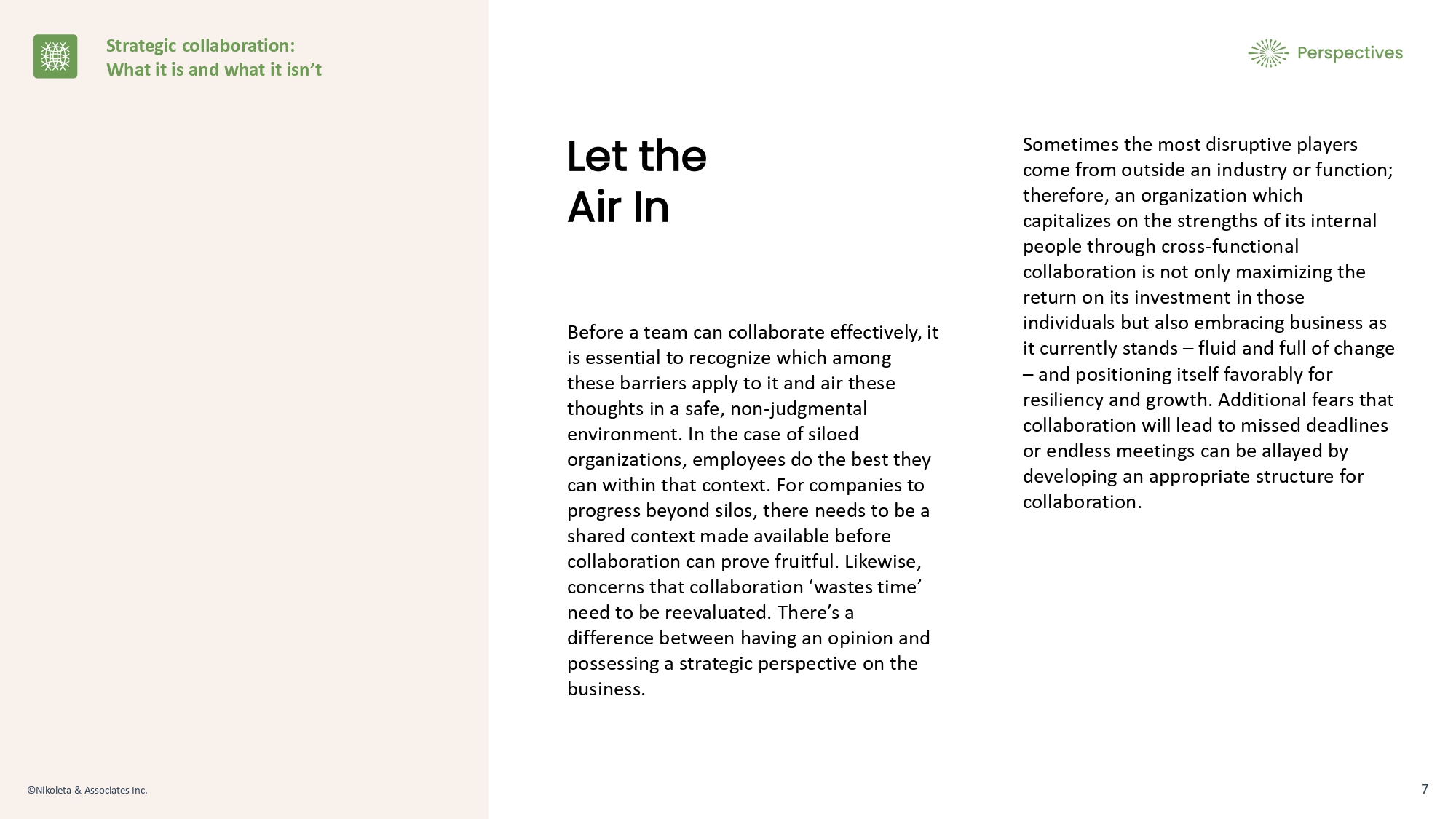Perspective
Strategic collaboration: What it is and what it isn’t


Numerous firms strive to foster a collaborative culture, where diverse perspectives unite to address common business challenges.
In our work, we’ve encountered some silent, often unconscious barriers to collaboration within many teams and organizations.
Moreover, conflicting definitions of what effective collaboration entails and uncertainty regarding its value persist. Our aim in this perspective is to present a clear picture of what collaboration looks like and how teams can effectively employ this potent strategic tool.
Effective Collaboration
In our experience, recruitment, revenue, and innovation are the primary outcomes of effective collaboration. For collaboration to transpire, companies need to establish a baseline understanding of how to collaborate across the organization. This understanding is underpinned by the following tenets:
- We (the organization) don’t accomplish anything alone
- The organization will gain more by engaging others and leveraging their viewpoints in effective collaboration rounds rather than not collaborating at all
- There exists a concept of diminishing returns when it comes to collaboration
- Collaboration is not about consensus, agreement, or achieving and maintaining compromise
- Nothing ever completes
When organizations encounter difficulty in collaboration, it often originates from the following barriers:
Siloes
The quintessential scenario of the siloed organization is the antithesis of cooperation, let alone collaboration. In such organizations, employees and leaders tend to concentrate on their direct responsibilities with little comprehension of their part in the overall scheme of the organization. For instance, sales might have no understanding of operations, IT may lack awareness or understanding of marketing, and HR may know little about finance. Individuals working in siloed organizations may be less likely to instantly embrace collaboration due to fear of losing track of their own space.
Your Role Defines You
Barriers to collaboration can stem from over-identification with a role. In these cases, any idea, task, or strategic direction emanating from outside an individual’s domain may be perceived as a direct threat to his or her identity. Take the example of ‘the smart person.’ Often a strong individual contributor, she derives ego satisfaction from being the person co-workers rely on for the best ideas. Perhaps his intelligence has not only spared the organization from a significant loss or disruption but also distinguished him in his personal life. Then, during a collaboration session, someone proposes a better idea; instantly, her status downgrades. Instinctively, she resists the idea to protect HER identity, regardless of whether or not the idea benefits the organization. This resistance is rarely ever conscious or intentional, but it can explain some forms of opposition.
Too Many Cooks
Another common and somewhat negative interpretation of collaboration is the adage ‘too many cooks,’ based on the underlying belief that collaboration is a sign of weak, wavering, or incompetent leadership. Given the busy schedules most professionals maintain in today’s business context, a prevalent concern is that initiating a dialogue session on any issue confronting the organization will result in weeks of extended debate while everyone gets a chance to voice their opinion.
Let the Air In
Before a team can collaborate effectively, it is essential to recognize which among these barriers apply to it and air these thoughts in a safe, non-judgmental environment. In the case of siloed organizations, employees do the best they can within that context. For companies to progress beyond silos, there needs to be a shared context made available before collaboration can prove fruitful.
Likewise, concerns that collaboration ‘wastes time’ need to be reevaluated. There’s a difference between having an opinion and possessing a strategic perspective on the business. Sometimes the most disruptive players come from outside an industry or function; therefore, an organization which capitalizes on the strengths of its internal people through cross-functional collaboration is not only maximizing the return on its investment in those individuals but also embracing business as it currently stands – fluid and full of change – and positioning itself favorably for resiliency and growth. Additional fears that collaboration will lead to missed deadlines or endless meetings can be allayed by developing an appropriate structure for collaboration.
Structure
How does a team know when it has collaborated enough and that a product, decision, or strategic direction can be solidified? The answer lies in design. A properly structured design for collaboration is crucial; depending on the organization, this might involve two or three rounds with clear deliverables at the end of each round. For instance, a brainstorming round may conclude with three scenarios which are then explored in-depth in the second round.
Creativity and Leadership
It’s also vital to provide a structure for creativity. Creativity is the bedrock of business and collaboration is meaningless without a space that supports out-of-the-box thinking. Collaboration in teams needs to transpire freely, openly, and without judgment. Lastly, collaboration needs to be led. Teams must appoint a leader who guides each round, keeps ideas flowing, and leads everyone towards the agreed-upon deliverable.
Closing Thoughts
Firms that embrace structured collaboration with clear end goals will reap the benefits of designed engagement. The solution to many of the company’s most perplexing business problems may already exist within the organization; the easiest and most effective way to discover them is through meaningful, cross-functional collaboration.















